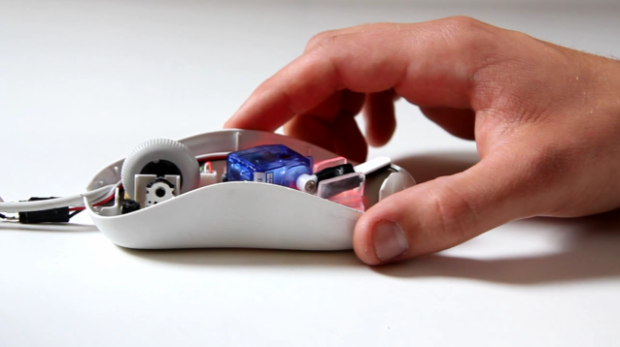Files and folders on your computer look and feel the same regardless of how much space on your hard drive they take up. Delete a 5-gigabyte file or a 5-kilobyte file with a simple click and drag of the mouse. Sure, one might take a little longer to delete than the other, but there’s no change in effort on your part. In the real world, we know that’s not true. Otherwise, shipping would probably be free for everything (or at least a flat rate). Jan Barth and Roman Grasy experiment with this idea with DataBot.
DataBot is a mouse that puts on the subtle brakes for larger files, so it feels heavier. There’s also a “breathing” function that shows you how often a file is opened. The lid of the mouse sort of opens and closes more rapidly for more frequently used files.
See the mouse in action below.
Do you really want your mouse to have more friction as you move your files on your desktop? Probably not. The whole point of the computer is to get things done quicker, not slow you down. However, as another signal or a way to interact with data (in addition to the visual), this sort of physical feedback might be useful one day.



I think it’s a good idea.
Work is not always about doing things quicker but also about making less mistakes. Although I guess, size is not always the correct measure to determine “individual weight” in sense of importance.
I agree with Christian about size not being the best measure of importance. I also wonder how this idea could be ported for people who (like me) make extensive use of the command line and/or keyboard shortcuts instead of the mouse.
I’m sorry. I think it’s a nice idea, but it’s not practical. Moving files is not about drag-and-drop with the mouse.
Most of the mistakes I’ve done when handling files didn’t involve drag-and-drop.
It’s a good idea if you could make it feel textures etc by having the ‘brake’ go on/off at various frequencies depending on the texture on the screen e.g. if you have a black and white maze, the mouse would brake every time a black colored wall is encountered. :-) that would be fun.
I think this is really interesting. I agree that I don’t (ever!) want to be slowed down, but some feedback in certain situations would be helpful. For example, say I have source data for a project that I received from a client. I’ve decided I do not want to alter it (so I can always revert to the original). I could tag that file, and if I select it, my mouse lets me know with a little vibration. If I chose to do something (move, open) with that file, I wouldn’t be slowed down, but I would know I’m dealing with something I’ve deemed important and would make me think for just a second before I renamed it to “what is this file?”
Though the idea in it’s current state may need refining, I can’t ever see a problem with more feedback (that I can control).
Another idea is to use force feedback found in joysticks but for a different purpose. Mouse could “resist” going out of certain areas, like menus or selected regions in image processing software. I find the “sticking” features in Photoshop extremely helpful, so it would be nice to have something like that on hardware level.
Not a good idea, it would tend to increase carpal tunnel/etc.
Who is the target market and what problem does this solve for them?
target market: oblivious computer users, typically older individuals, who attempt to send emails with 20+ MB attachments.
Problem solved: the above users will create emails that can actually be sent and received.
Well, I like it. May not have much immediate practical use but I love that this has been invented, for whatever reason!